Tertiaries and Minors
Zip Dobyns
Secondary progressions are the most common system of progressions, but they are not the only ones. The general term “progressions” refers to the use of astronomical ratios which say that the patterns in the sky at one time in an individual’s life describe the psychological issues (and possible events which stem from them) existing at a different time in the life. Secondaries analyze the sky as many days after birth as the individual’s years of life. To look at issues faced when one is ten years old, you examine the sky ten days after birth. The system makes no logical sense but it “works.” It is reliable and helpful, giving insight into the “natural unfolding” of the character—the psychological potentials shown in the birth chart. As with the natal chart, the astrological-psychological principles can be manifested in the life in many different details which depend on the individual’s insight and choices.
Tertiary progressions look at the sky one day after birth for each lunar month of life. Each time the transiting Moon returns to its natal place, you look one day later in the ephemeris. Minor progressions analyze the sky one lunar month after birth for each year of life. By the time an individual is one year old, the Moon will have crossed its natal position 12 times and be on the way to 13.
We can summarize the ratios as: a day for a year for secondaries; a day for a lunar month for tertiaries; a lunar month for a year for minors. The earth rotates on its axis in a day, so from our point of view the Sun appears to circle the earth. Astronomically, these ratios equate the Sun appearing to circle the earth with the earth actually circling the Sun; the Sun appearing to circle the earth with the Moon actually circling the earth; the Moon circling the earth with the earth circling the Sun. One system is no more “logical” than another, but they all seem to “work,” to provide insight including the times of possible changes in the life.
Minors may have been invented or discovered by C.C. Zane, founder of the Church of Light. His writing was my original source of the technique. They are very easy to use since the minor progressed Moon is similar to the transiting Sun. It travels through the zodiac in a year so it moves very close to one degree a day. Use of the lunar constant lets the student find the current positions of the other planets. The lunar constant is simply the difference between an individual’s date of birth and the degree of the natal Moon. A person born on June 10 with a Moon in 15 degrees of Aries has a lunar constant of 5. On the tenth of every month, the minor progressed Moon will be at 15 degrees of some zodiacal sign, moving one sign a month. On August 10 every year, it will be in 15 Gemini. On October 10 it will always be in 15 Leo. The other planets can be calculated according to the Moon’s degree.
You can count to your present age by paging through the ephemeris, adding a year of age each time the Moon returns to its natal position—about every 28 days. There are also tables in existence which give the approximate number of years, months and days to add to the birth date to find the proper date in the ephemeris for the minor progressions. Tables for secondaries, tertiaries, and minors were included in the appendices of my book Progressions, Directions, and Rectification which can be ordered from ACS in San Diego. When I worked with minors B.C. (before computers), I kept in mind that at age 30 the minor progressed date was two years and about 3 months after the birth date. At age 40, the minor progressed date is just under three years after the birth date. I would count lunar months backward or forward from these dates, remembering that during the “right” day in the ephemeris, the Moon crossed the degree of the natal Moon. Of course, if you have a computer program like CCRS, it will do the calculations for you.
Tertiaries are a little more complicated to calculate (unless you have a computer program), but there are also tables which help you find the right date in the ephemeris for the desired year of life. You can page through the ephemeris, counting each time the Moon returns to its natal place (12+ a year) until you reach your current age, then go forward in the ephemeris that number of days after your birth date. The table will tell you that at age 27, the Moon will have returned to its natal place 361 times, just 4 days less than a year after your birthday. The table also has a column headed “Inc” for “increment.” The figure in this column gives the number of days in the current lunar month which you are past the ephemeris date for the given age. The motions of the Sun and Moon do not match. Astronomers say that they are incommensurate. Ancient astrologers had problems with this and often maintained two calendars, a solar and a lunar one and sometimes one for Venus as well, and they struggled to find ways to correlate the different cycles. This increment in the Tertiary table represents the fraction of the lunar month which must be added to the ephemeris date to find the accurate planetary positions for the corresponding year of life. The table offers only two ages where there is a 0 increment. At age 30, the Moon has made 401 revolutions so the tertiary progressed date in the ephemeris is one year and 36 days after the birth date. If you go past February in a leap year, that would add a day to your year so you would only count 35 days more than one year. The other 0 increment age is 68 when the Moon will have made 909 revolutions, taking you nearly two and two/thirds years past your birth date in the ephemeris.
I assume that most of our readers are familiar with secondary progressions and with the convenience of the calculated date (CD) in working with them. Zane called it the “adjusted calculated date” (ACD) and others call it the “limiting date” (LD). Zane also had his own name for secondaries, calling them “major” progressions to match his “minors.” The CD is based on the individual’s Greenwich time of birth and on the ephemeris being used, noon or midnight. The CD is the calendar date on which the secondary progressed positions of the planets in the ephemeris are accurate. The ephemeris date used is, of course, one day later than the birthday for each year of life, but the CD is always the same calendar date for an individual. For example, a person using a midnight ephemeris who was born at noon UT (GMT) would have a CD six months earlier that his or her birth date. By the time the person was six months old, an astrologer would check the day after birth to see the planetary positions for secondary progressions, and they would be accurate as given in the ephemeris for that age of six months. If exact positions were desired for the birthday when the baby was a year old, the planets would have moved halfway through the day after birth so additional calculations would be required. In the days before computers, I would just take the planets from the ephemeris for the proper date, counting forward a day in the ephemeris for a year of life, and I would know that they were accurate for the CD. The P Moon moves from twelve to fifteen degrees in a day which equates to a year, so its secondary progressed monthly movement is a degree or a bit more and the astrologer can easily estimate when it will be moving into or out of aspects to the other planets and angles. The P Sun moves five minutes a month, etc.
Our modern calendar is based on the earth’s revolution around the Sun, so the Sun is in approximately the same degree of the zodiac on the same day every year. As an alternative to the calendar date, we could use the zodiacal degree of the Sun on our calculated date. But this CD technique which lets us match the secondary positions of the planets with a calendar date only works for secondaries since the calendar is based on the earth-Sun movement.
As described above, the lunar constant provides a basically equivalent and easy way to match the minor progressions with calendar dates. The minor progressed Moon is moving at the same approximate speed as the transiting Sun, so it lets us match the planetary positions with the normal, western solar-based calendar by knowing that our minor Moon will be in a certain zodiacal degree on a specific day in the year.
The closest equivalent to this technique for tertiaries is called the tertiary Moon (T-Moon). When this is calculated, and as with the CD it is based on our UT of birth, we can use the tertiary Moon to match the planetary positions in the ephemeris with the calendar. Each month when the transiting Moon crosses our T-Moon, we go one day later in the ephemeris and we know that the planets are accurate at the time in that day when the T-Moon is exact. Since the Moon moves twelve to fifteen degrees a day, some calculation is still required if we want planetary positions accurate to the minute, but the day will give accuracy within a degree for all except Mercury and Venus when they are fast (close to the Sun).
The technique starts like the method for calculating the CD. The UT of birth is subtracted from the ephemeris time (noon or midnight). The resulting hours are divided by two and the minutes by four. In calculating the CD, the hour division becomes months and the minute division becomes days and they are added to or subtracted from the birthday to get the CD. For the T-Moon, the hour division becomes degrees and the minute division becomes minutes and they are added to or subtracted from the natal Moon’s zodiacal position. If the UT is later than the ephemeris time, the result is subtracted. If the UT is earlier than the ephemeris time, the result is added. For both the CD and the T-Moon, there are actually three columns, the first being completed zodiacal signs, the second months (for the CD) or degrees (for the T-Moon), the third days (for the CD) or minutes (for the T-Moon). The first column has to be completed signs in case you have to add or subtract a whole zodiac of 12 signs. A position in Aries is in 0 completed signs while Pisces is in 11 completed signs. The same method of adding and subtracting three columns is used in calculating Arabic Parts. Of course, a computer can save a lot of work. Since transits, secondary progressions, minor progressions, and solar arc directions are all quite easy to calculate, I suspect that many astrologers have ignored the somewhat more challenging tertiaries. But they can be a very useful key to major issues and times of change. Professional astrologers obviously cannot do every technique for every client, but they might want to try tertiaries out on their own charts and family members, and consider them if they feel the need of additional information when dealing with a client with serious problems. A recent contact with a former student reminded me of their value, and he has promised to write an article for The Mutable Dilemma on some of his work with tertiaries. In the meantime, I went back to our recent presidential election to see whether tertiaries or minors might have provided additional insight.
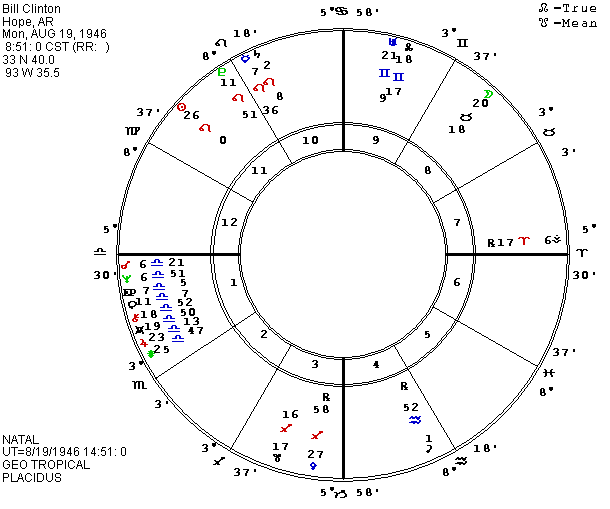
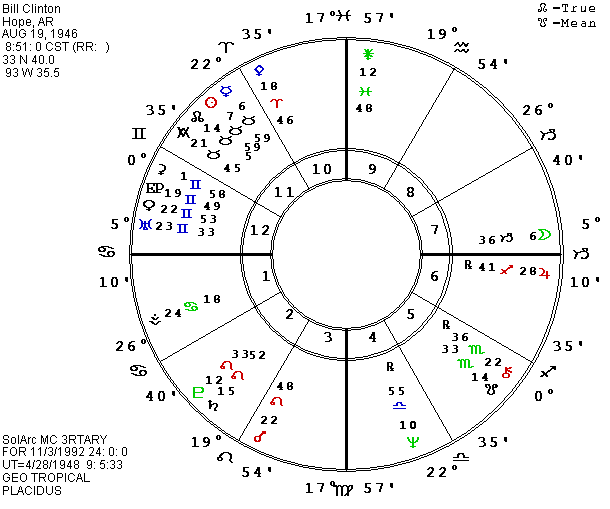
As readers know, I had the wrong birth times for Bill Clinton and Dan Quayle until just before the election. Now that we have a birth certificate time of 8:51 A.M. for Clinton, the chart is making much more sense and his tertiaries for the election are certainly dramatic! I use a capital P as shorthand for secondary progressed planets and will use a T for the tertiary positions. But don’t confuse the T Moon with the T-Moon described above or with transits for which I often use a capital T. On the Election Day, Bill Clinton had his T Moon on his natal IC and his T Ascendant on his MC forming a cardinal cross with his natal Ascendant-Mars-Neptune and Vesta on his Descendant! In all forms of progressions, the orb is limited to one degree. T Jupiter was on natal Pallas, for reaching his heart’s desire in politics. T Venus trined natal Jupiter, sextiled T Mars, and was conjunct T Uranus in the house of Jupiter. T Neptune was still in a long sextile to Pluto. T East Point trined natal Chiron and Antivertex and T Pallas opposed Chiron and was semisextile T MC. T Sun and T Mercury were trine T Moon but square natal Mercury and quincunx natal Mars-Neptune-East Point. T Ceres was sextile Clinton’s tenth house natal Saturn. As listed, there many positive aspects and in view of the challenging job Clinton is taking on, it is certainly appropriate to have some potentially negative ones.
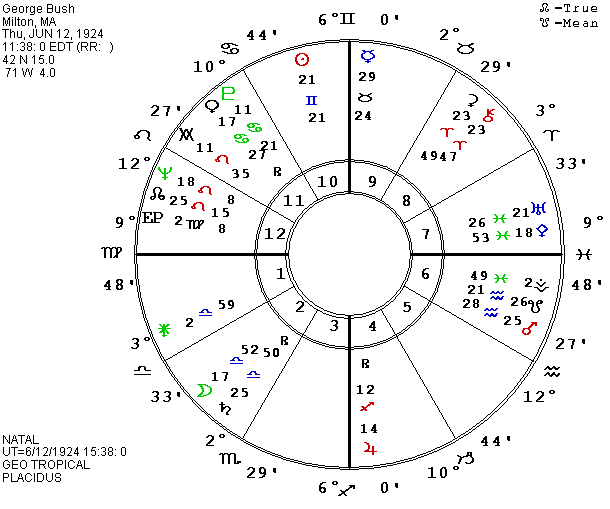
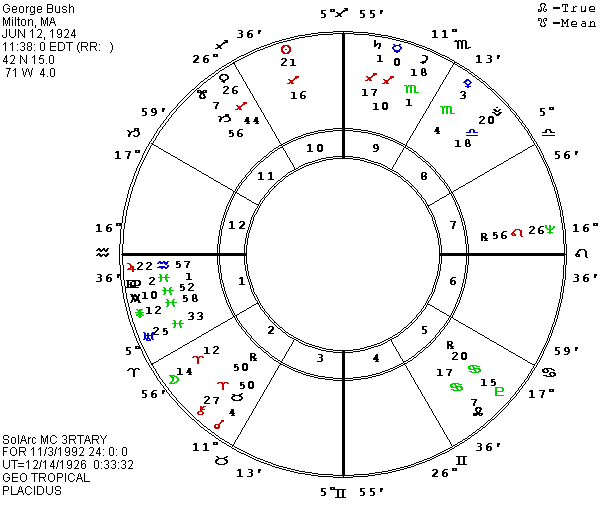
In George Bush’s tertiaries, T Sun was opposite his tenth house natal Sun within five minutes of longitude and square natal Uranus, making a T-square out of his natal square. Since I progress the MC with the solar arc, Bush’s T MC was opposite natal MC, the whole combination suggesting a change of job and home! To further hammer in the message, T Mercury (ruler of his MC and Ascendant), T Saturn (key to executive power), and local T MC were all opposite Bush’s local MC in Washington. T Saturn was also in orb of a square to natal and progressed East Point which opposed each other across the sixth and twelfth houses. T Ascendant in the sixth house was quincunx natal Venus and T local Ascendant in the local sixth house was quincunx Pluto, more clues to a change of job. But there were also positive aspects, including T Vesta sextile T Sun, T Venus sextile the north lunar node and trine T Neptune, T Jupiter sextile Chiron and Ceres, and T Mars trine the Washington natal Ascendant. In general, I would read the chart as a change of job and home but not as a threat. The implication is that he might be better off, healthier and perhaps even happier as a result of the change, with lots of opportunities to take on new projects.
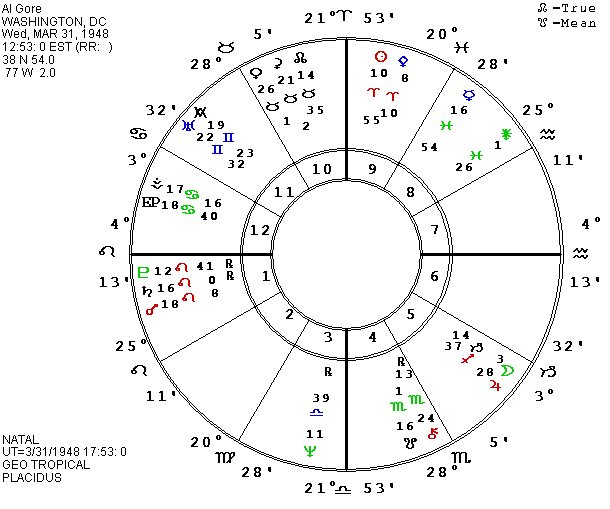
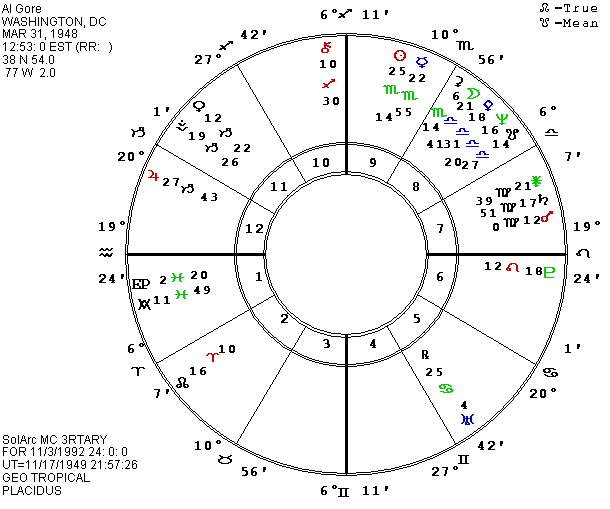
Al Gore also had several appropriate tertiary aspects including T Moon opposite the natal MC and T Sun in the fourth house opposite natal Venus in the tenth house, both fitting a change of job and home. T MC was trioctile natal MC for another suggestion of job and/or home change, and T Chiron trined the natal Sun to support his realization of personal goals. T Ascendant was trine the Antivertex to suggest the ability to do what he wanted to do. T Antivertex had a powerful indication of change with a double quincunx (yod) to Pluto and Neptune and an opposition to T Mars—all of them aspects which can lead to separations. T Saturn’s sextile to Vesta and the East Point point to potential success in the career and T Pallas sextile Mars and T Pluto say it again. Though there are always some conflict aspects, Gore’s tertiaries certainly look like a winner.
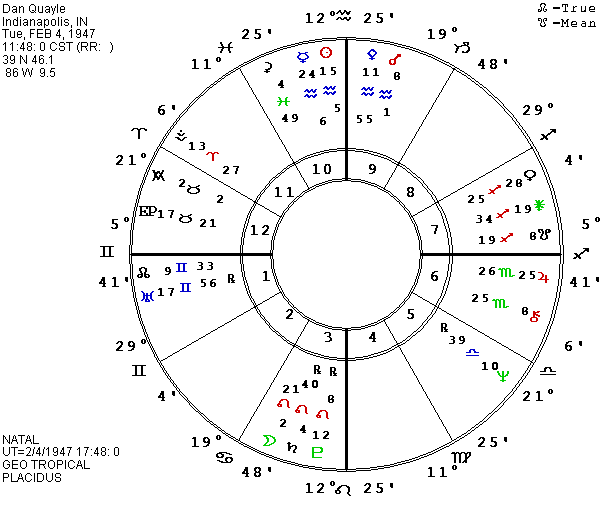
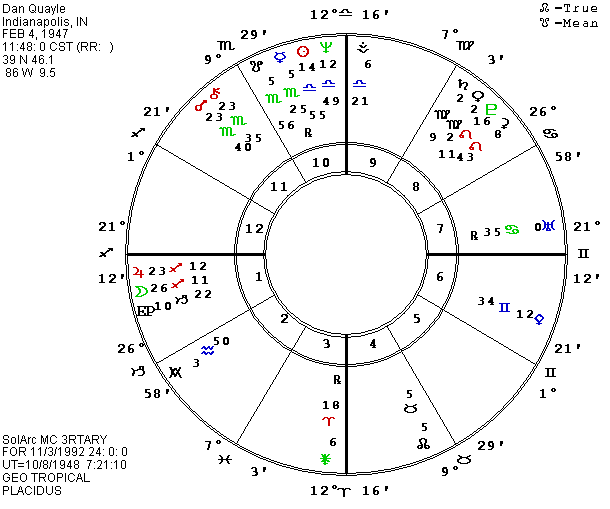
Dan Quayle’s tertiaries were much more mixed, with some very favorable aspects which would have really presented a challenge if I had been analyzing them before the election. He had a grand trine including natal MC-Pallas, T Pallas, and T Neptune-T MC with the latter three factors in fire houses and holding sextiles to natal Pluto. The combination looks like a career winner, and it is supported by T Jupiter sextile natal Mercury and T Mercury trine natal Ceres, both of the natal factors in the tenth house of executive power. T Saturn on T Venus could be read as pleasure associated with the career, especially since they were semisextile natal Moon and trine the Antivertex. T Mars on T Chiron suggests action that achieves goals. T Ceres sextile-trine the lunar nodes is positive for work and relationships. There were some aspects for challenge and change including T Antivertex opposite natal Saturn. T Mars-T Chiron were square natal Mercury and T Mercury-T south lunar node were quincunx the Ascendant, but the picture is overall very positive. Now that we know what has happened, we can interpret Quayle’s patterns as the protection (luck?) of a family owning a newspaper which he might take over, and perhaps even some psychological relief that he will no longer be the butt of all the comics in the country.
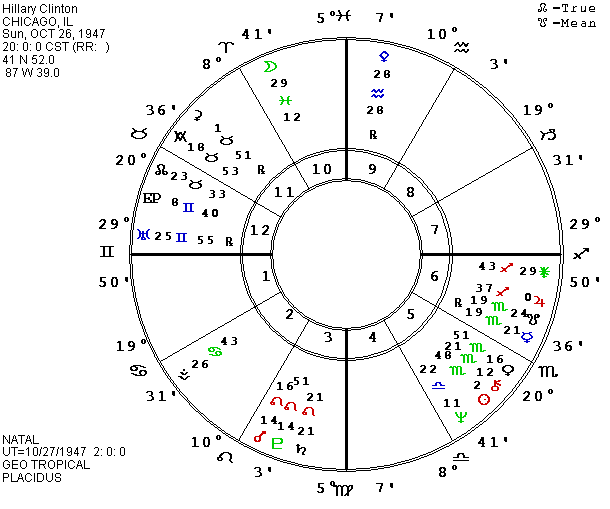
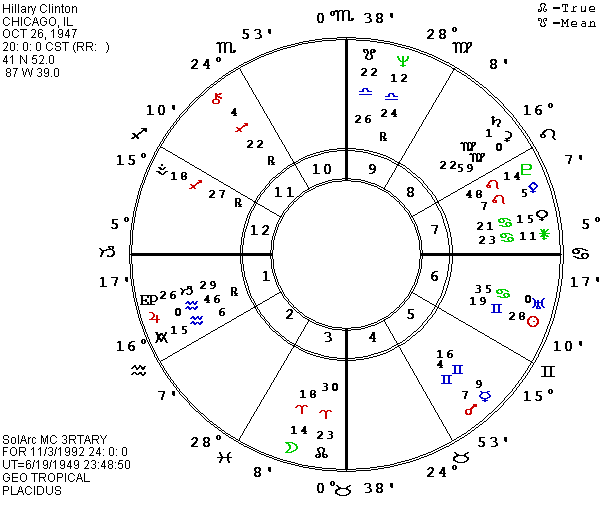
We do not have full data for Marilyn Quayle, but the other wives also had interesting aspects. Hillary Clinton had T Uranus on the Ascendant and opposite Juno, the marriage asteroid, for the past few years as she struggled to save her marriage. Her T Sun was just coming to the Ascendant at the election. It would reach the one-degree orb about two weeks after the election and hold the aspect for about two months, most of the interval up to the inauguration. It will be on T Uranus for the inauguration in January 1993. Other aspects for the election included T Ascendant sextile natal MC for career success, and T Saturn on T Ceres trine natal Ceres and sextile T MC which says the same thing. T Saturn-T Ceres were also square Jupiter in the sixth house and quincunx T Jupiter in the eighth house, clearly indicating the inevitable tension between Hillary’s ideals and what will be possible. T East Point opposite Vesta also fits a job change and their placement in the second and eighth house shows a financial change.
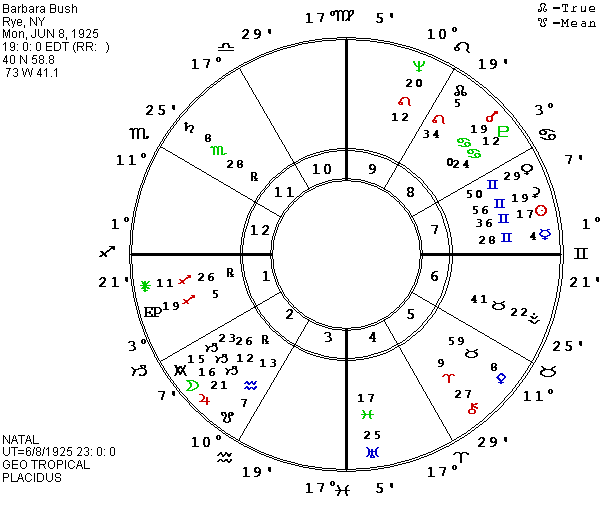
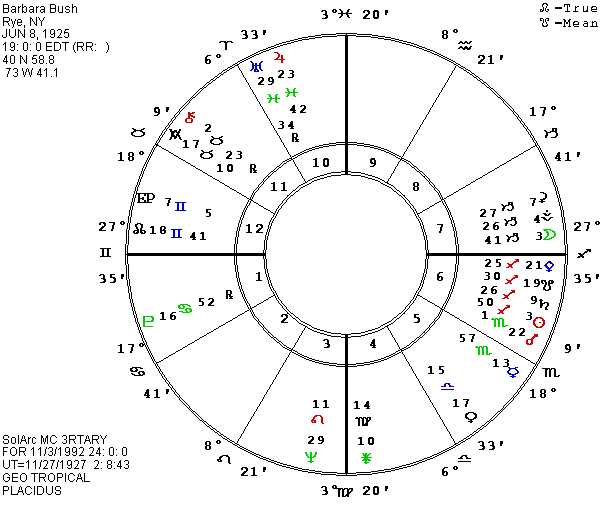
Barbara Bush has T Uranus in a long quincunx to T Neptune and square to natal Venus showing her peripatetic husband and home. At the election, her Sun square MC which is a lifetime aspect was also aspecting T Moon on T Vesta with the latter two quincunx natal Mercury, in her seventh house and ruler of her tenth house. These aspects fit changes of job (Vesta and the MC), home (Moon), fame and power (Sun) and relationships (seventh house). T Venus in the tenth house was square her natal Moon in Capricorn, again fitting career changes, but it also trined natal Sun in the seventh house so maybe she will get a little more time with her husband. From what I have read, she does love him and would like more time with him.
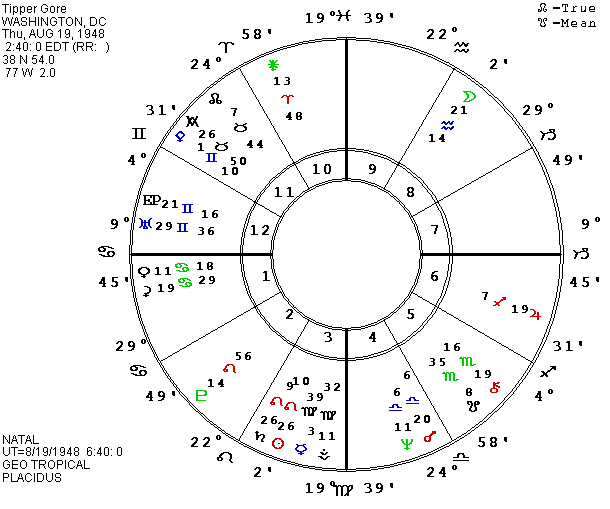
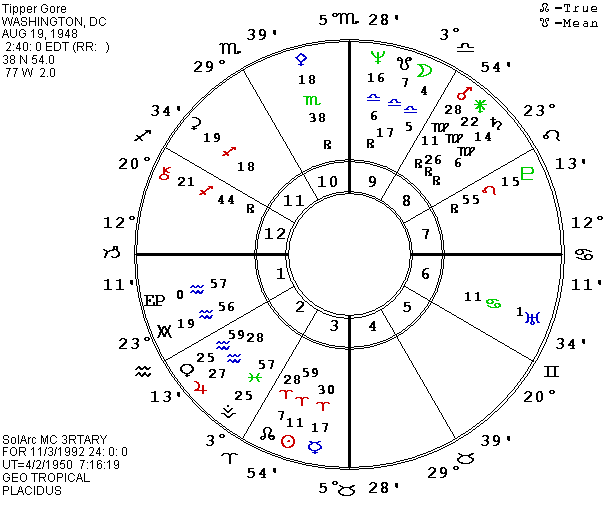
Tipper Gore’s tertiaries were loaded with change aspects including T Venus opposite natal Saturn-Sun, T Vesta quincunx Saturn-Sun, T Jupiter quincunx T Mars, T East Point quincunx T Uranus, T Sun opposite Neptune, T Chiron making a station in the sixth house opposite the East Point and square T Juno, T Ceres conjunct Jupiter and T Pallas conjunct Chiron. The last two suggest attaining an important goal. There are always more aspects which could be mentioned, but the main emphasis in the chart points to change. Hindsight, we can say she is changing her life dramatically as a result of her husband winning the election, but foresight might have left us wondering whether all those separation aspects just meant being separated from her goals.
As I wrote in the last Asteroid-World, I had only done secondaries and solar arc directions for contenders before the election and I was thrown off by not having accurate birth times for Bill Clinton and Dan Quayle. But even with hindsight, the secondaries and arcs in Clinton’s chart are far more stressful than the tertiaries. Using only the secondaries and solar arcs, if conflict aspects were a sign of losing the election, Bush would have been the winner. Astrologers are challenged when we get a somewhat different picture from different systems. Obviously, we have to keep on watching and testing the different techniques.
I have also done the minor progressions for the five contenders for whom we have birth data but I will not take the space to discuss them here. I will briefly mention one other chart which I calculated after the election. Astrology emphasizes that valid charts are drawn for the first occurrence of anything. The first vote in our presidential elections is cast at midnight on Election Day in a tiny town in New Hampshire—Dixville Notch. If I had looked at that chart, I might have changed my forecast! Heliocentric Saturn was in a one-degree square to the MC in Dixville Notch and geocentric Saturn was just two minutes over the one-degree square to the local MC in Washington, DC. Those aspects certainly did not bode well for the incumbent executive.